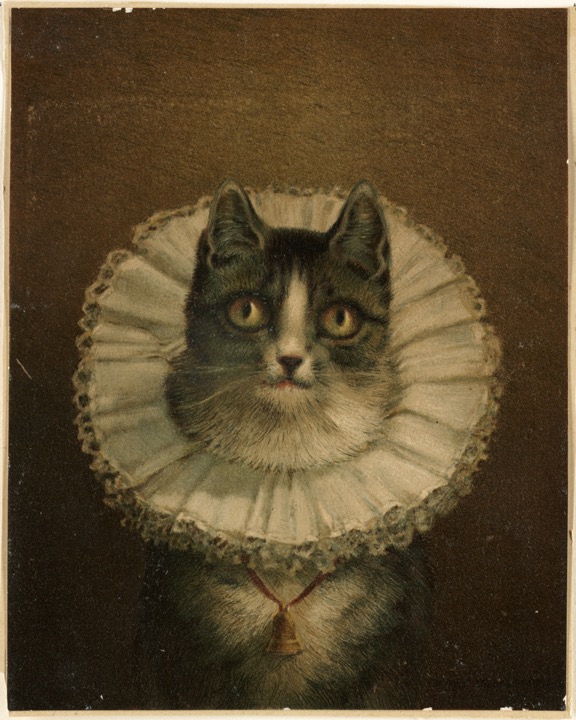1500s: The Elizabethan Ruff, Manicured Beards and Arum Starch #1
16/09/13 /20:39 Category: Timeline
Part 1: How Arum made 5ft wide Elizabethan Ruffs possible.

image: wikimedia.org http://bit.ly/196qHVa
The Elizabethan era was to fashion what the Precambrian era was to evolution: a time when a whole variety of strange forms came into being, had their fun and then promptly died out, leaving only those more practical designs to pass on down the ages. Ruffs are the trilobites of fashion: in their day widespread and successful, today well known and generally much loved by current generations. They are the ‘type fashion’ of the era and, like trilobites, completely extinct.
The ruff evolved from the ruffle. The word and the garment, hand in hand defining the fashion of an era. Ruffles appeared early in the 13th century, as simple strips of crimped trimming added to sheets as a decoration. Fittingly, the word originates from the Germanic ruffelen, meaning ‘crumpled’. By the 15th century, ruffles were used around the neckline of items of clothing such as chemises, those smock-like precursors to modern-day shirts originally worn by women. They served the distinctly practical purpose of saving a wearer’s ‘shirt’ or top clothing from becoming soiled around the neckline (think how modern shirt collars suffer). Being detachable items they could be washed separately, thus avoiding the need to launder a whole smock or shirt. Very sensible, those Tudors.
With the quickening of the Elizabethan era, ruffles left their utilitarian roots behind them. Hearing the call of destiny, they became ever more ornate and distinctly non-utilitarian items of fashion and status. Bedecked with jewels and arranged into tiers, ruffs (as they were now called), sported varied shapes, numerous styles and a range of colours, all peculiar to the wearer’s class and gender. Such were the dictates of Elizabethan society on class and clothing that the yellows, reds and purples favoured by the upper classes is said to have given rise over time to the ‘Lords and Ladies’ name for Arum.
The most extreme ruffs grew to become over a foot (25 cm) wide: supported by internal frames to bear their weight. Such constructions could often comprise over 15 feet (5 m) of cloth. Cecil Prime describes how bearers of such ruffs could hardly walk or bend whilst wearing them. At one point it was clearly felt to be getting out of hand and Queen Elizabeth banned such extra-wide ruffs. All jolly good fun no doubt, but such experiments in fashion were made possible only by a single discovery – Arum starch.
We do not know how or when, but at some point it was realised that Arum was not only a source of starch but that it produced such a very fine-grained and white starch that it was on a par with that derived from rice and wheat and, indeed, from arrowroot itself. Arum quickly became prized for its suitability for laundry starching, giving a strong and stiff structure to the cloth. So pronounced were its stiffening qualities that, combined with the newly imported Dutch starching techniques, anything seemed possible. People began experimenting. Ruffles seemed a good place to start: thus was born the ruff. The fashion designers of Elizabethan times embraced Arum wholeheartedly and it is no exaggeration to say that it is Arum that made the whole wonderfully outlandish extravagance of Elizabethan ruffs possible.
Demand for Arum was considerable for a time, but its super-starch strength came with a significant cost due to its effect on people’s skin – not the skin of the lords and ladies, but the skin of their washerwomen. Unlike rice or wheat, Arum contains the incessantly irritant calcium oxalate crystals. These needle-shaped crystals are of such tiny size that they penetrate into the very pores of the skin whereupon they cause intense itching, chapping and blistering. They are equally damaging whether one is handling the leaves or the roots, and Arum starch soon became renowned for causing severe and painful blistering to the hands of the laundry maids who made it. Gerard stated, ‘It choppeth, blistereth and maketh the hands (of the poor launderesses), rough and rugged and withall smarting’.
In part 2: Starching Your Beard, Slovenly Solicitors and the original Elizabethan Mr Angry.
Read more on the iPad book here: http://tinyurl.com/wildarumipad
blog comments powered by Disqus